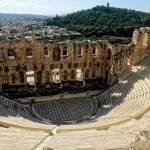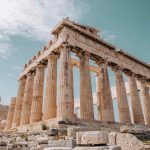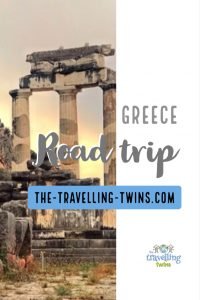
Greece is made for road trips. You can enjoy pebble and sandy beaches surrounded by turquoise waters, but nothing tops taking a road trip around Peloponnese or Athens to Meteora. A road trip in Greece is usually punctuated by picturesque villages, dense forests, ancient sites, and beautiful national parks.
If you are looking for road inspiration in Greece, we had compiled our itinerary from when we visited the country at the end of last year.
This road trip starts in Patras and ends in Ioannina.
Let’s get started.
Patras
Our road trip began in as here we arrived by ferry from Bari (a town in Puglia) to Patras – the third-largest city and the capital of Western Greece. We found Patras being a bit crazy, double parking arund all streets, hectic traffic and muggers. Yes, that’s the only place where we got mugged during our road trip around Europe.
This city is great for starting a road trip, lying in the foot of Mount Panachaikon and overlooking the Gulf of Patras. The setting of Patras is simply calming and usually offers an excellent starting point for many Greek road trips.
Before starting the journey, visit sites such as the Cathedral of Agios Andreas, Roman Odeon, and the archaeological museum.
From Patras, drive about an hour to the next stop, Castle Tornese.
Castle Tornese
Caste Tornese or Chlemoutsi in Greek is a medieval castle located some 75 kilometres from Patras. The castle was built in the 1220s by the Crusader leaders of the Principality of Archaea as their fort.
Located on a plateau 226 meters above the sea level, Castle Tornese comprises a hexagonal keep erected around the inner square and containing double-storied halls along its length.
The castle forms a breathtaking example of fortress design during the Frankish era.
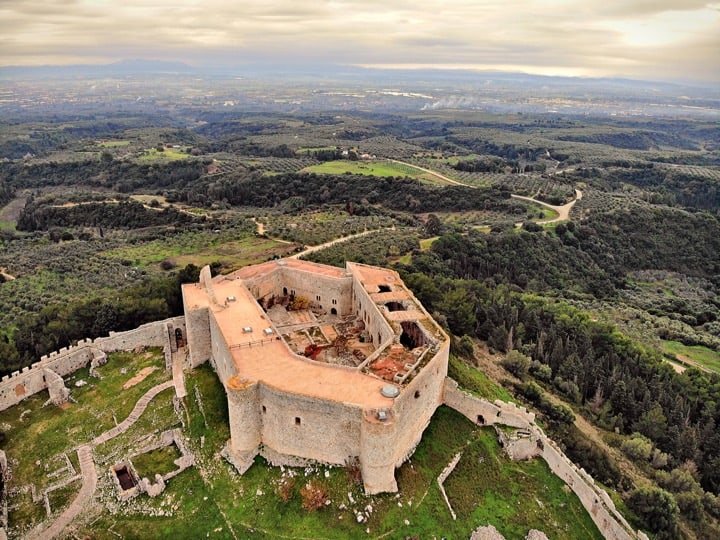
In the same region of Elis, you will find the town of Olympia.
Olympia
Now the Peloponnese road trip is starting to get interesting. Ancient Olympia is one of a historically important city in Greece, having been the birthplace of the Olympic Games. Before the games began to be staged across the world, they used to be held in Ancient Olympia, and every four years, each city in Greece used to send its outstanding athlete to take part in the games in honor of Zeus, the father of gods and men. During the games, any war or conflict would be ceased, and the winners would walk away with an olive garland and everlasting glory.
So a visit to Ancient Olympia gives you an opportunity to learn about the history of the Olympic Games and have a race at the remnants of ancient stadiums as we did.
- Google Map Location
- Opening hours
- Daily 08:00 – 08:00
- Typical Entry and Other Prices
- Adult: 6€
- Child (from EU):free
- European Landmarks
- The Most Interesting Facts about Athens
- Facts about Parthenon
- Movies about Greece
Archaeological Museum of Olympia
When you are here to not miss the Archaeological Museum of Olympia it’s a great museum which has lots of artefacts from Olimpia. It’s a perfect place for worldschoolers to have a history lesson.
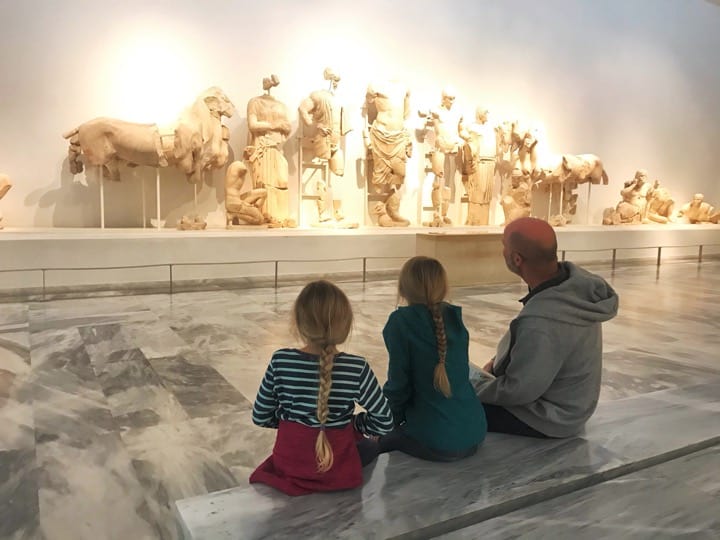
- Museum Website
- Google Map Location
- Opening hours
- Daily 08:30 – 03:30
- Typical Entry and Other Prices
- included in the entry price to Archeological site
This small town is an excellent place to stop and relax as you explore what it has to offer. Check out the Olympia Land Winery and sample some of the famous Greek wines.
Where to stay in Olimpia?
Insider tip: – next to Olimpia you can find an Open Theater Floka – its a great site to visit. During summer you can see here a play or a concert, in winter you can act and be public yourself.
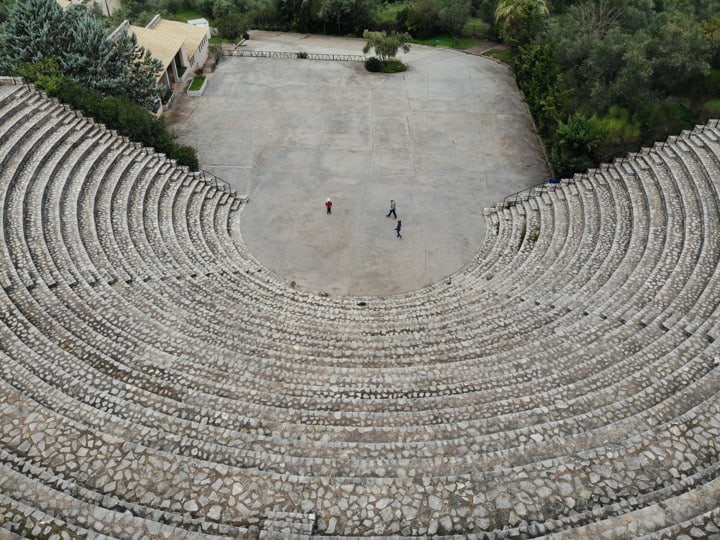
Lagkadia
Lagkadia or Lagadia is a beautiful mountain town at the centre of Peloponnese and is amphitheatrically built on a vertical wooded slant of Mainalon, with 70 degrees inclination.
This small town is also known as the “hanging village” since it appears to hang over a gorge formed by the Touthoa River.
Lagadia has a storied history and played a central role in the liberation struggle of Morea against the Turks.
While here, enjoy some of the region’s best delicacies including splenandero, lamb, intestines, and salted meat.
Dimitsana
From one mountain town to another, Dimitsana is a small village in Arcadia. With a choir of red-roofed building s across two hills at the start of Lousios Gorge, Dimitsana is a great stop for learning more about Greece’s struggle for self-determination.
Its Greek school, which was founded in the mid to late 1700s, is believed to be the birthplace of the revolutions against the Turks, so there is a lot of learning in this small town if you are a history buff. The town was also known for its many gunpowder factories and a division of Filiki Eteria – Friendly Society – a spot where Greeks met to plan a possible uprising against the Ottoman Turks.
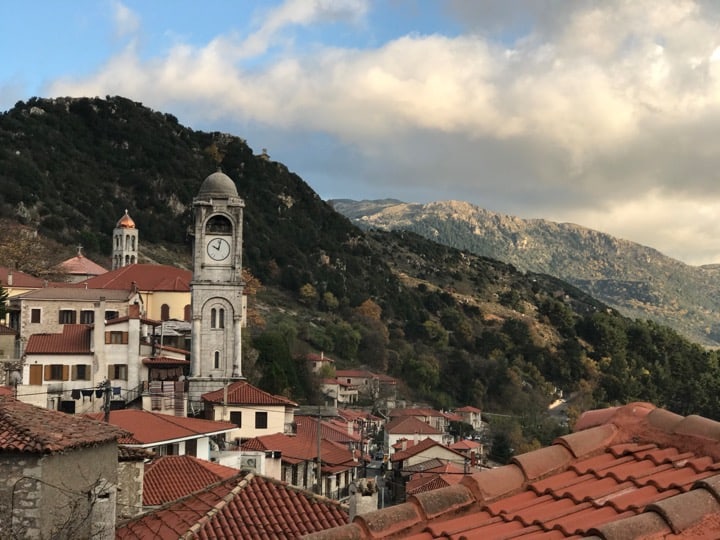
Its Greek school, which was founded in the mid to late 1700s, is believed to be the birthplace of the revolutions against the Turks, so there is a lot of learning in this small town if you are a history buff. The town was also known for its many gunpowder factories and a division of Filiki Eteria – Friendly Society – a spot where Greeks met to plan a possible uprising against the Ottoman Turks.
Besides history, this historic village is also a very popular winter destination despite the fact it is barely known by tourists.
One of the highlights of the town is the Dimitsana Town Library, which houses a fascinating collection of folklore with artifacts depicting day to day life in the village, especially in the 19th century. The Ecclesiastical Museum is also another place where you can learn a few things about Dimitsana.
Hiking the Lousios Gorge is one of the best outdoor activities in Dimitsana. The trail begins at the Open-Air Museum and takes you down to the gorge, where you will encounter some breathtaking landmarks. There are plenty of monasteries along the sides of the canyon, as well as a number of old water mills.
NOTE: If you want to hike during winter, make sure you have equipment that is suitable for snow.
If you have time, and packed sports gear, check out the recreational activity at the River Lousios.
Enjoy the crisp mountain air before embarking on your journey.
Karytaina
Karytaina is another picturesque village in Arcadia. It is also built atop of a hill and around a medieval castle, 580 meters above the ground. It is located just 54 kilometres from the city of Tripoli and 20 kilometres from Megapolis.
This village will impress you with its mountainous views. If that is enough to get you excited, the two or three-story pebble houses sure will fascinate you.
Be sure to check the Frankish castle in the south of the village and atop a cliff.
Basses – Apollo Temple
This archaeological site is a must-visit during a Greek road trip. It is located in Oichalia in the northeastern region of Messenia but used to be part of Arcadia during the ancient time. This site is famous for the 5th BC Temple of Apollo – one of the most studied ancient temples in Greece due to its multitude of rare features.
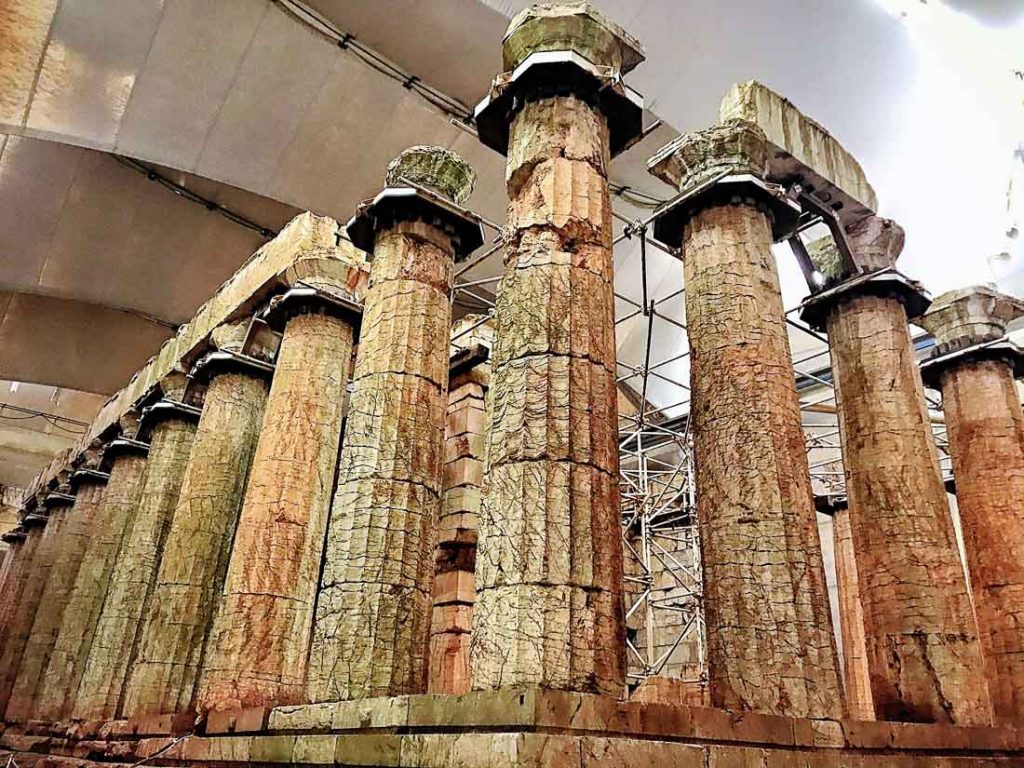
Neda Falls
Neda Waterfalls are one of the most popular in the South Peloponnese and offer a nice stop for relaxing before you continue with your road trip. Located in the lush green gorge near the small town of Kyparissia, this little paradise is created by a 30 kilometers long river running between Ilia and Messinia regions.
It is a great spot to stop by and enjoy some breathtaking nature walks and cycling in the Neda valley. The trails connect the waterfalls and beautiful villages via stone bridges with striking viewpoints and windmills along the way.
Reaching the Neda Waterfalls is very easy, especially if you are in the small village of Platania, which is just 15 minutes away from the falls.
There are two falls; the first one is closest to the village, while the second one is located further up the trail near the small chapel of Panagia on the cliffs.
Besides hiking, if time is on your side, you can take some river trekking trips.
Palace of Nestor
The Palace of Nestor used to be an important centre during the Mycenaean periods. It is the largest structure in the region surrounded by ruins of ancient settlements. The settlement here dates back to 1300 BC, but this palace was once ravaged by fire in around 1200 BC.
The roof of the palace has since been replaced by a modern structure, and now the palace is open to the public from 2016.
Chora – Museum of Chora
This archaeological museum is located in southern Greece with collections focusing on the Mycenaean civilization. Some of the items on display include the Murals from the Palace of Nestor, Casts from Clay plates, and two impressive pithamphorae.
Polilimnio Waterfalls
Polilimnio Waterfalls are often termed as one of the most beautiful destinations in the Peloponnese peninsula. It offers a fascinating experience if you want to get out of an ordinary lifestyle.
Monemvasia
This small town in Laconia is also a must-visit during your Greek road trip. It is located on an island linked to the mainland by a 200 meters causeway. Monemvasia is usually touted as the town for Lovebirds due to its raw magic.
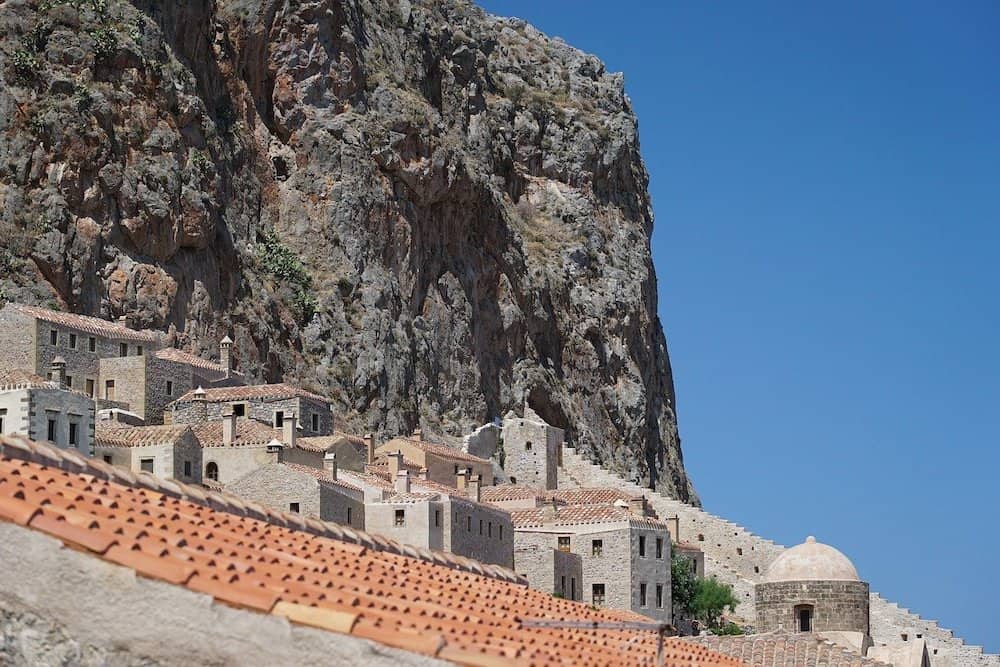
The town used to be a fortress during the times of Byzantines, Franks, Venetians, and Ottomans.
Monemvasia is the only castle in Europe that has never been vacant since its construction.
Sparta
Sparta is a town in Laconia that lies at the site of ancient Sparta. The town has a number of museums such as the Archaeological Museum of Sparta, the Archaeological Museum of Mystras, and the Angakis Art Gallery.
Mystras is a famous Byzantine site that spans almost halfway up the hill. Up there, which is quite a long and tiresome hike, there are a number of churches, some of which feature well-preserved frescoes. A steep path leads to the church of Pantanassa, where there are still some nuns living in the facilities.
The Museum of the Olive & Greek Olive Oil is also a nice place to spend a few hours. The museum, as the name suggests, covers the mysteries of the olive from as early as 60,000 BC to the present day.
Kyparissi
Kyparissi is a small village town along the northeastern shores of Laconia. What you can do here is enjoy the beach, particularly Kiparissi Beach, which is long and quiet.
This small, charming village is a gem that is only known by a few people, partly because of how hard it is to get there. The journey there involves crossing icy mountains and riding a kayak, but after arriving, you will be glad you went through all that trouble.
Unsparingly, Kyparissi has featured in many travel magazines as well as books such as The Most Beautiful Villages of Greece, and its notable visitors include Prince Charles and President George H. Bush. It is also believed to be the last destination Princess Diana visited before her doomed trip to Paris.
With its modern infrastructures, it is possible to stay in Kyparissi for a week or more before continuing with your journey elsewhere.
During the ancient time, when it was still called “Kyfanta” Kyparissi used to be known around the region as a therapy center. People used to come from all corners of the continent to bath in bathtubs curved on natural rocks and filled with water from the thermal spring nearby.
If you have time, visit the ruins of the prehistoric city at Palaiochora as well as the little church Koimisis Theotokou and the Byzantine castle at Kastelli.
In terms of beaches, the village is known for its two shorelines – Megali Ammos and Mikri – both of which have pebbles, sand, and turquoise waters that are perfect for snorkeling.
Nafplio and Fortress of Palamidi
Fortress of Palamidi can be accessed by either a car or by foot and having been built 216 meters on a hill, you will have to work your way up there. Up there, you will get to enjoy the views of the Argolic Gulf and Nafplio. The fortress was constructed by the Venetians around 1711 and 1714 and is believed to be one of the most striking masterpieces of military architecture despite being stormed in by Greek soldiers in 1811.
When it comes to the small town of Nafplio, which is usually dubbed the most romantic in the whole of Greece, there are many reasons to pitch your tent here for a few days or even a full week. The town was originally the capital of Greece between 1823 and 1834 and as such, it features some beautiful Venetian-inspired architecture and traces of Ottoman style,
Nafplio is an ideal getaway from the capital Athens, particularly because it is only 2 hours away. A trip from Athens to Nafplio follows the picturesque northern Peloponnese.
It is also here that you will find the Archaeological Museum, where you can learn a few things about the history of Greece. The gallery is located in a Venetian building and its permanent exhibition includes some of the oldest artifacts from the Paleolithic Era, including clothing, figurines, sculptures, jewelry, and ceramics as well as some vestiges from the Neolithic Period.
The convenient location of this town makes it an ideal base to explore the rest of the Peloponnese, including the cities of Mycenae, Corinth, and Tyrins, which are all just a drive away from Nafplio.
If you don’t want to venture out of town, there are a variety of sandy beaches and hidden coves. Walk along the beachfront promenade to the succession of beaches such as Neraki, Karathona, and Arvanitia.
Mycenae
Mycenae is an archaeological site that you must visit during your road trip to Greece. It is located near Mykines in Argolis northeastern Peloponnese. The fortified citadel is situated on top of the fertile plain near the coast, and its somber yet mighty presence hides centuries of history.
Named after “Mycenaean” it is the largest and most important center of Greek civilization. A graded road 3.6 meters wide starts at the Lion Gate at the main entrance to the citadel, and leads up a ramp that is bolstered by a five-terrace wall and onward to the southwestern gate of the castle.
Lion Gate is the most popular attraction in Mycenae and has two lions on top, but you can also visit Treasury of Atreus, a vaulted catacomb believed to be of Agamemnon, the well-known king of Mycenae. It is also believed that the king’s golden treasury was buried inside with him, and though the tomb had been already looted way before it was discovered by the archaeologists. Speaking of vaulted tombs, there is also the Tomb of Clytemnestra from 1,200 B.C, which was discovered with golden jewelry.
Other attractions include Cyclopean Walls, massive walls of Mycenae believed to have been constructed by Cyclops – some one-eyed giants.
The Archaeological Museum is also worth a visit and it features exhibits from the nearby excavation sites. Located near the Lion Gate, the museum features two floors.
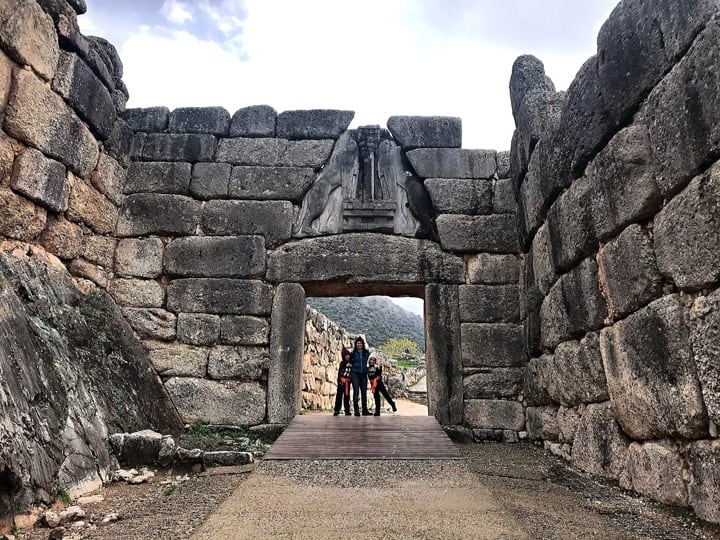
Named after “Mycenaean” it is the largest and most important centre of Greek civilization and one of the most recognizable landmarks in Greece.
Epidavros
Located near Mycenae is the Epidaurus, a former city in ancient times. With plenty of points of interest including Stadion, Gymnasium, Odeon, and Public Baths, this is one of the most famous archaeological sites in the whole of Greece.
Epidavros was built based on the sanctuary of Asclepius, the Greek god of healing. If you look carefully, you can see ruins from the old sanctuary, especially in areas around the Ancient Theater of Epidaurus.
Fascinatingly, this theater is still functional today and usually hosts Greek plays in summer. Nearby, there is an Archaeological Museum housing findings from excavations from the sites around.
On top of the hill above the ancient village of Nea Epidaurus, around 15 kilometers from the archaeological site, you will find the vestiges of a Medieval Castle. Its location atop the hill was for protection purposes against the pirates and enemies. There used to be three churches inside the walls of the castle – the churches of Panagia, the church of Saint Theodosios, and the church of Saint John, the latter of which is still standing today. Also, near this medieval castle is a spot where the original Constitutional Meeting of the contemporary Greek State took place in the 1820s.
Ancient Corinth and Corinth
Ancient Corinth is a famous site with ruins of Apollo temple.
Modern Corinth is a successor to a medieval city of the same name in Peloponnese. The city was founded in 1858 as New Corinth after a devastating earthquake destroyed the old city.
There are plenty of things to do in Corinth, but the most common site is the Canal.
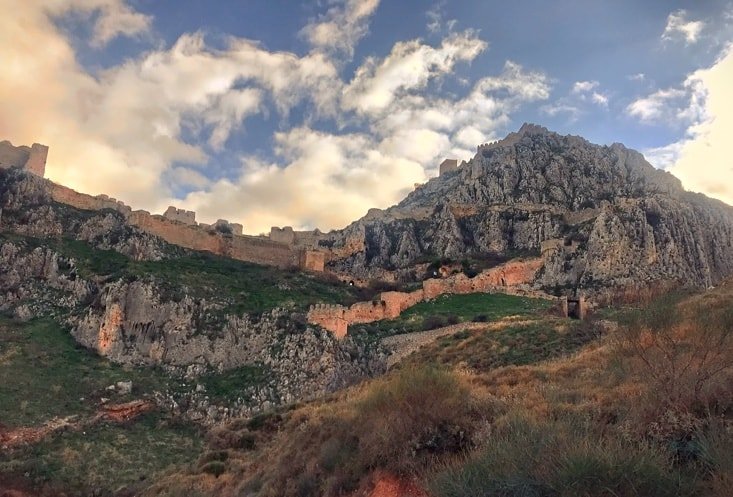
Choros Hraion
Choros Hraion is also another archaeological site in Peloponnese, 15 kilometres northwest of Ancient Corinth. The temple of Hera was found during an excavation process in the area. The temple is one of the most significant ruins of the ancient Corinth.
Athens
The largest and capital of Greece, Athens has a lot of to offer, including museums, parks, and many ancient sites. This classical city usually attracts plenty of curators and digital nomads. There also numerous fine restaurants where you can enjoy some of the best Greek delicacies.
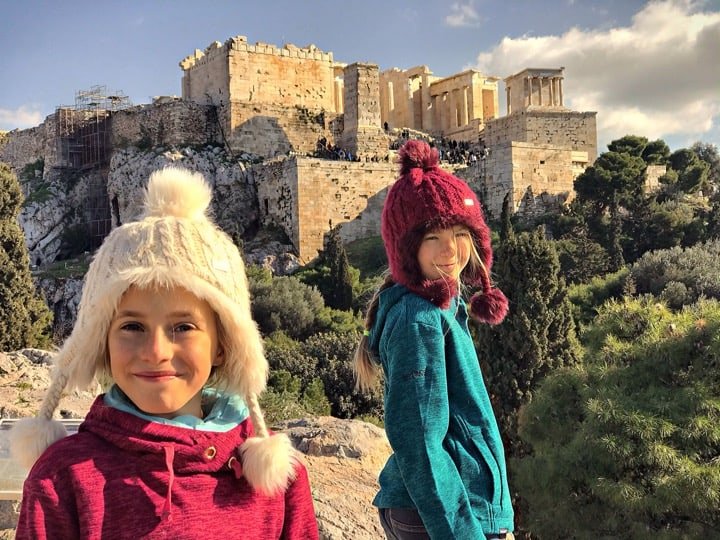
Read our article on things to in Athens With Kids
Sounion
Cape Sounion is a promontory in the southernmost end of the Attic peninsula, and a few kilometers south of Lavrio. It is known for its Temple of Poseidon, one of the most important monuments of the Golden Age of Athens.
Other temples include the Temple of Athena Bastion Delta.
Sounion is also an ideal day trip from the capital Athens since it is located just 70 kilometers away. The landscape between Cape Sounion and Athens is breathtaking and thus the trip also offers you a chance to discover and experience the beauty of this countryside.
The best time to check out the Temple of Poseidon is at sunset when the sun falls below the Aegean. Fun fact about the Aegean is that it was named after King Aegeas who mistakenly jumped to his death after he thought Theseus, his son had died.
Delphi
This ancient sanctuary is used as the capital of Pythia, the oracle from the ancient classical world. Though it is not usually a cup of tea for many tourists, Delphi is a great destination for a day trip.
The Temple of Apollo is one of the main attractions of Delphi. It is situated at the end of the Sacred Way and used to be the seat of Pythia – the high priestess. The temple’s deepest chamber, Adyton, was accessible only by the priestess and the priests during the announcement of the prophecies of Apollo.
Next to the Temple of Apollo lies the prehistoric theater of Delphi. This ancient auditorium can accommodate around 5,000 people and it used to host musical competitions as part of the Pythian Games of Panhellenic Games of primeval Greece. Walking along the theater’s tier to the west, while soaring up the highest level of the site, you will come across the Stadium of Delphi, one of the best still-standing stadiums from ancient Greece. Here you will find the stone aphesis – the starting point for athletes.
The Tholos of Delphi is another site not to be missed. Dating back to the 4th century, it is one of the most outstanding ancient structures in Delphi and a testament to ancient architectural prowess.
To learn some history, check out the Archaeological Museum of Delphi, which houses find from the site.
Last but not least, the charming village of Chrisso offers a much respite from the antiquity of the Delphi site. This small town is located exactly where Krissa – an ancient city – used to be. Though it is a bit modern compared to its surroundings, the village is protected by the state of Greece as a monument and offers visitors a chance to explore its paved streets and appreciate its astounding neoclassical architecture.
Because there are very few things to do in this town, it is more suitable for complete relaxation after a long day in other cities. But because of its countryside landscapes, visitors can hike along its many ancient trails that pass through small villages, chapels, and forested hills.
This ancient sanctuary is used to the capital of Pythia, the oracle from the ancient classical world.
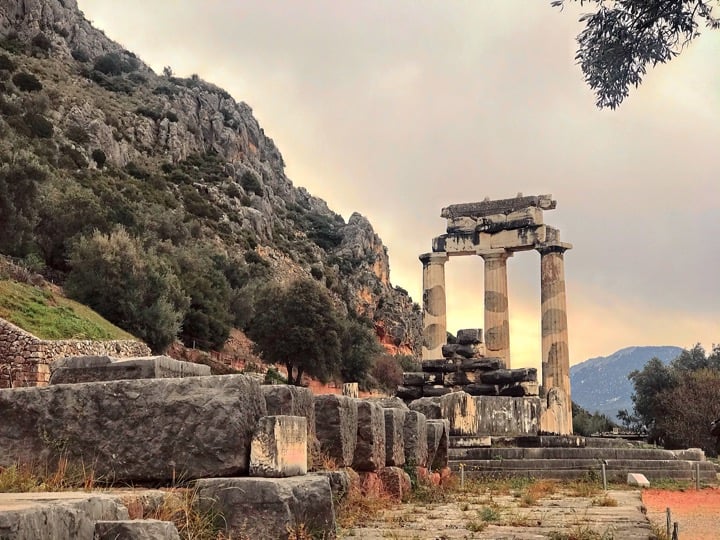
Visitors can check out the Temple of Apollo, Treasuries, and Amphictyonic Council.
Meteora
Meteora is a UNESCO World Heritage site in a place that means “suspended in the air.”
It is basically an eroded rock on which monasteries were built by monks. In order to reach the monasteries, you will not only need ropes and ladders, but also strong upper body stamina. They were meant to be difficult to enter, and that is why they were perched atop the rocky boulders.
These monasteries draw plenty of visitors, but if you want to avoid the crowd, you can hike up the remains of abandoned monasteries that are scattered around the region.
Aside from the monasteries, you can check out the hermit and jail caves peeking from the faces of the soft rocks. There are different caves for different purposes – the ones where hermit monks would spend their days in solitude, the ones where locals would keep their sheep and goats at night, and the ones where ‘naughty monks’ would be jailed. Discovering these caves is one of the best adventures in Meteora!
Thanks to the climate of this area, there are lots of mushrooms around Meteora, so much that there is even a Mushroom Museum where visitors can learn a few things about these fungi.
For a relaxing evening, sample some wine and tsipouro or explore the nearby small town on foot, including the towns of Kalampaka and Kastraki.
Meteora is a popular rock climbing destination and attracts people from all over the world.
It is believed that the rocks in Meteora were formed around 60 million years ago due to the action of weathering and earthquakes.
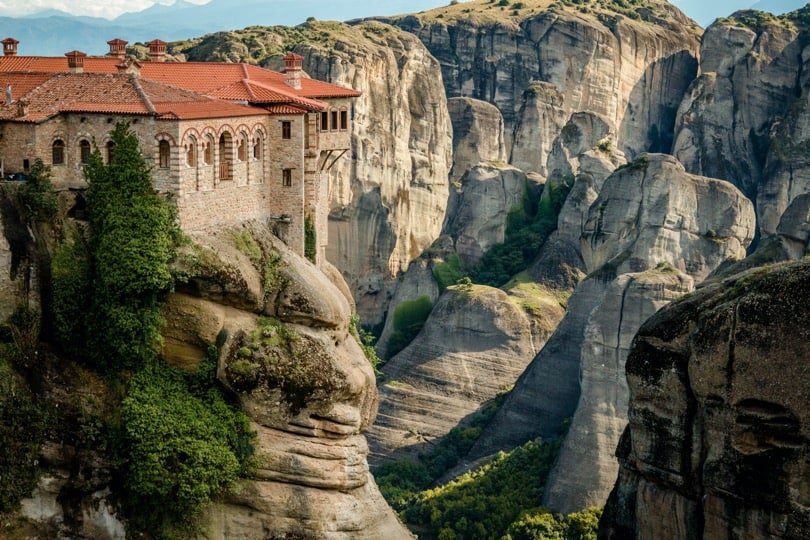
Ioannina
Ioannina or Yannena is the largest and the capital of the Ioannina region in north-western Greece. Some of the landmarks in Ioannina include the Isle of Lake Pamvotis, Ioannina Castle, Municipal Art Gallery of Ioannina, and the clock tower in the central Dimokratias Square.
Though this small, charming town barely makes it into most travel guides and magazines, it has plenty to offer.
Its historic town center is packed with a plethora of different cultures including Jewish, Christians, and Muslim. The paved streets are fringed by coffee shops, bars, and mezedopoleia – small food joints where foods are served in smaller portions.
One of the best things to do with the family in Ioannina is taking a boat ride on Lake Pamvotida to the islet where there are some beautiful ancient monasteries and dining options. Local legend has it an Ottoman ruler called Ali Pasha ordered a girl to be drowned in the lake after she turned down his sexual advances.
Another family-friendly activity in Ioannina is visiting the Domaine Glinavos winery. It was opened in 1978 by Lefteris Glinavos – one of the first oenologists in the state of Greece. The winery uses locally grown grapes such as the white Debina, Vlahiko, and Bekari.
Road trip around Greece – Conclusion
We spent over a month traveling through Greece, and every place we have seen was better than the other. Greece is full of amazing archeological sites all close to each other making it perfect for a road trip.
From Greece, we went to explore Albania in a camper.
Greece Road Trip – Pin it for later


